Genre: Board Game Developer: Sculptured Software Publisher: Parker Brothers Players: 1-8 Released: 1992
Who doesn’t love themselves a rousing game of Monopoly. The “World’s Most Popular Boardgame” was always fun for me to play, but recently I’ve found that there’s a resentment towards it from a large portion of the Internet board gaming community. Yes, sadly, there’s an Internet board gaming community… but that’s neither here nor there. The fact is Monopoly has always been an extraordinarily popular game, and as such has seen video game adaptations over the years. From the Master System to the N64 to the PS2, Monopoly has had a presence, however miniscule, in the video game industry for years now. The Sega Genesis saw its own adaptation of the classic board game; how does it stack up?
The first thing you’ll notice is that Monopoly on Genesis can be played with up to eight players, all of which can play on just one controller, though you can use another. Moreover, you can play with a combination of friends and computer opponents or just against computer opponents. When you start playing, you’re asked to provide your name and select your game token; if any computer opponents are involved, you’re asked to choose from a selection of characters, each of which has their own personality and AI tendencies.
Seeing as the entire game is, of course, a computer program, there’s no need for anyone to be the banker, and the computer takes over those duties, cutting down on a lot of time. No more do you have to count your money precisely, as the computer keeps track of it all for you. Each game begins with the computer picking a player at random to go first. You’re then taken to the main game screen. The main game screen is an overhead visual representation of the classic Monopoly game board. The Monopoly logo in the middle, the Chance and Community Chest cards, and indicators for how many houses and hotels there are to buy from the bank.
When it’s one’s turn, they roll the dice. Like Clue, this is accomplished via the A button. A hand appears onscreen shaking dice, and when you release A, the dice are thrown and a random number on the dice appears; your game token then moves that amount of game spaces. When your token moves, there’s a cut scene in the middle of the game board – replacing the entire middle, but keeping the game border around it – of your token moving. It’s nicely animated, and the backgrounds correspond to where you are headed. You’ll see and hear a moving train if you’re heading towards one of the four train stations, you’ll see a home with a FOR SALE sign if you’re heading for an unowned property, an excavated home for an owned property with no houses, a house for a property with houses, the dreaded hotel for a property with a hotel on it, electricity and water stations with accompanying sound effects, bank tellers at the GO space, a government building for the tax spaces, and more. It’s all very well done. The animation isn’t spectacular, but the graphics are colorful and it all lends personality to the game, as if you’re moving about a real location.
The game follows standard Monopoly rules, though before you begin there’s an option to play set scenarios, or set who owns what and who has how much money. I personally have never tinkered with it, opting instead to play standard Monopoly. It’s worth noting there are no “house rules.” Aside from rolling the dice, before each turn you can also press the B button to see a quick screen to see who owns what property deeds, or the C button to start interacting. Here you’ll find menus to buy houses and hotels for your property, mortgaged and unmortaged property, try and set up trades with other players, and scroll through the property deeds. It’s all right out in the plain and there’s nothing confusing about any of it.
When you land on an unowned property you can either buy it or send it to auction. Sending it to auction in this game takes you to a screen with an actual auctioneer, and each player can place their bids in an effort to win the property. This follows the old Monopoly tactic of landing on an unowned property when your opponent has little money, and sending it to auction just so you can easily outbid their small amount and buy the property for a small price. It’s not a foible of the video game, it’s a foible that’s always been in Monopoly; some like it, others don’t, but the video game stays faithful. When you land on Chance and Community Chest spaces, the card is brought onto the full screen and a brief and repeating animation of Rich Uncle Pennybags is shown on it. Again, the animation isn’t anything special, but they could have easily went with just a static card image, so it’s nice to see a little effort.
The main criticism with real Monopoly and, by default, with this game, is that it owes a lot to chance. The roll of the dice is important, as there’s no way for you to set where you’re going to land outside of dumb luck. But hey, that’s a board game. There’s still a lot of tactic involved, such as knowing when and what to trade or mortgage, and it’s still fun trying to haggle with a friend so you can own that last piece of land you need so you can start building houses. It’s not as fun trying to negotiate with a computer, as is to be expected, but at least you can notice different character ‘AI’ differences amongst what the computer characters are or are not willing to do.
The main way to win the game is, of course, to bankrupt all of your opponents. When a player cannot afford to pay rent or other fees, he must choose to go bankrupt, and he’s out of the game. It’s accompanied here by a humorous screen of Rich Uncle Pennybags picking a fish skeleton out of the trash, and the game then continues if there are still other players involved. One huge complaint is that the game can go on for entirely too long. This is remedied somewhat here, as you can choose to ‘End Game’ if you’re tiring out, and here the player with the most net worth is declared the winner.
If you’re unaware of the Monopoly game rules, the instruction manual does a good job of lining them out. If you don’t have the instruction manual, Wikipedia’s a good place to look them up; the complete rules are entirely too long for me to attempt to relay in this review. Needless to say, if you’re a fan of the board game, I’m sure you’ll enjoy this adaptation. It’s all the fun of Monopoly, with added colorful graphics, and none of the hassle of setting up and putting away the game board and pieces. It’s not a great game, but it’s a decent way to pass time.
SCORE: 6 out of 10


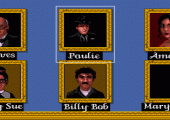
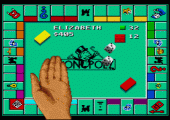
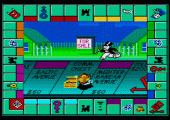
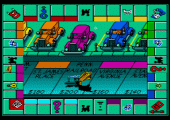
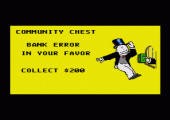
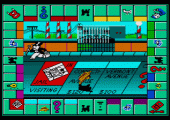
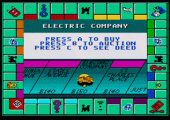
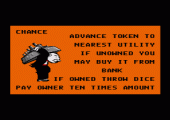
Recent Comments